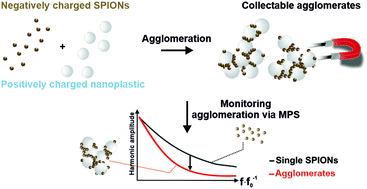Real-time monitoring of magnetic nanoparticle-assisted nanoplastic agglomeration and separation from water†
Abstract
Nanoplastics are one of the main modern concerns in water pollution and are suspected to have severe negative impacts on their surrounding ecosystems. The use of superparamagnetic iron oxide nanoparticles (SPIONs) as remediation agents is a suggested approach to address this issue. Their nanoparticulate and switchable magnetic properties enable a homogeneous distribution while magnetic collectability is feasible. However, uncertainties regarding an incomplete collection from treated water remain, which would pose another environmental burden. Herein, the nanoplastic remediation approach via SPIONs is investigated by utilizing magnetic particle spectroscopy (MPS) as an advanced qualitative characterization method. This work focuses on the influence of concentration ratio and colloidal stability of nanoparticles on the overall remediation process. Herein, MPS enables the in situ real-time monitoring of the agglomeration events and illustrates that high colloidal stability of the SPIONs prevents the formation of large, destabilized agglomerates and thus their successful magnetic removal. Furthermore, it is shown that at high SPION concentrations, nanoparticle residuals are left in dispersion after collection of formed agglomerates, while at low concentrations nanoplastic leftovers are found. Colloidal stability and concentration-dependence of the agglomeration process are recognized as key aspects to focus on when developing future particle-based materials for nanoplastic remediation from water.

- This article is part of the themed collections: Nanomaterial applications in water and Nanocircular Economy Papers 2014-2022


 Please wait while we load your content...
Please wait while we load your content...